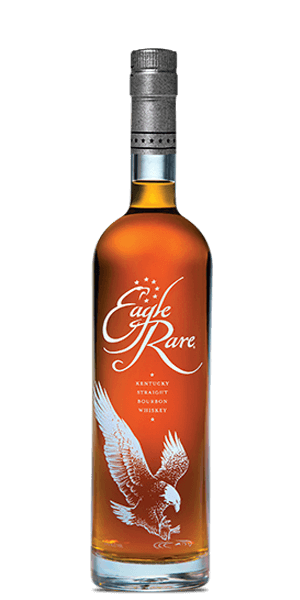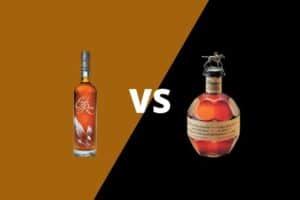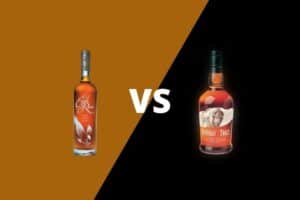If you’ve spent time perusing the many bourbon-focused websites, blogs, social media groups and messaging boards sprinkled across the internet, you’ve seen the hype that orbits Eagle Rare 10 Year Bourbon. But behind the bourbon rankings and published bourbon release dates, there’s a lot more to consider.
In this Eagle Rare Bourbon review, we’ll take a look at why discerning bourbon drinkers consider this the perfect ‘gateway bourbon’ — one that will make a believer out of anyone on the fence about whether they’re a fan of the bourbon category.
We’ve got a lot to dissect, so let’s get to it!
History
The 1970s were a tumultuous time of transition in bourbon country.
Sales of bourbon were tumbling as a new generation of drinkers turned away from the whiskeys of their parents and towards unaged spirits — including a crystal clear product with origins out of the Soviet Union. Vodka was the latest fad and its rise came at the expense of the overall whiskey category.
In 1968, Charles L. Beam became a master distiller for the Seagram’s spirits division — at the time, the largest producer of distilled spirits on the globe. Charlie Beam was a member Beam distilling family. He was the grandson of Joe Beam, the first cousin of James ‘Jim’ Beam.
Charlie recognized the dip in sales and an increase in aged barrel inventory as an opportunity to launch a new brand. In doing so, he helped create a new breed of bourbon. But few at the time would’ve guessed it was to be the last major bourbon launch for about two decades.
Eagle Rare was launched in 1975 as an homage to Wild Turkey. Both brands had bird-themed names and were bottled at 101-proof.
Eagle Rare was launched with a 10 year age statement as a way to one-up the more established brand. Although bourbon sales continued to decline through the 1970s and into the 80s, the Eagle Rare brand survived.
In the 1980s, Seagram’s began offloading spirits brands, and in 1989 Sazerac purchased the Eagle Rare and Benchmark brands to begin its bourbon portfolio. At the time, Sazerac did not own a distillery, so the juice was sourced from Heaven Hill until Sazerac purchased the Buffalo Trace Distillery in 1992.
In 2005, the bottling proof for Eagle Rare was lowered from 101 to 90-proof and marketed as a single barrel product.
Mashbill
Sazerac does not disclose the mash bills — or list of grain ingredients — for any of its range of bourbon or rye whiskeys. However, many sources have reported that the mash bill for Buffalo Trace’s ‘Bourbon No. 1 Mash Bill’ contains about 10 percent rye.
Distillation & Production
Since 1992, Eagle Rare has been mashed and distilled at the Buffalo Trace Distillery in Frankfurt, Kentucky.
In 2018, Sazerac announced a $1.2 billion upgrade to the Buffalo Trace Distillery. While the expansion is still underway, new cookers, fermenters and maturation warehouses have come online in recent years.
These improvements are seen as a way to address severe supply shortages for many Sazerac brands. Eagle Rare is a great example of an industry-wide problem — although it retails for a suggested $30 a bottle, well-versed bourbon hunters know finding a bottle at that price can be a struggle. In control states where state law dictates prices reflect manufacturer’s suggested retail prices — or MSRP — bottles fly off the shelves as soon as a shipment arrives. In non-control states, retailers often raise prices to reflect what customers are willing to pay — sometimes $150 per bottle or more.
About the year 2012, Sazerac changed the packaging for Eagle Rare. The 10 year age statement was moved to the back of the bottle, and the words ‘single barrel’ were removed from the label.
The explanation for the removal of the single barrel language was a new automated bottling line. As the processing equipment switched from one barrel to the next, spirit from two barrels could mingle in the bottling line. The removal of the terminology from the packaging ensured the brand would not run into any trouble with the U.S. Tobacco and Alcohol Tax and Trade Bureau’s (TTB) strict definition of ‘single barrel.’
Today, customers can still enjoy a single barrel bourbon at a reasonable price by pouring a glass of Eagle Rare 10 Year Bourbon.
Maturation
That 10 year age statement on the bottle guarantees each barrel used in the production of Eagle Rare has been matured for a minimum of 10 years.
Age statements are something the TTB takes seriously. To get the label approved, the producer must be able to track the maturation of each barrel throughout the lifespan of the aging process.
For bourbon production, the TTB mandates that only new American charred oak barrels may be used. Eagle Rare uses No. 4 ‘alligator char’ barrels during the maturation process. These heavily charred barrels are exposed to open flame for nearly a full minute, leaving dark and thick ridges on the inside of the barrel that resemble the bumps and ridges on the back of an alligator.
Once the barrels are filled, they are stored in the many warehouses on the Buffalo Trace Distillery campus to mature. Barrels for multiple brands are simultaneously maturing in the warehouses’ many floors. Once a barrel reaches the requisite 10 years, the blenders must taste to make sure the liquid inside meets the criteria for an ‘Eagle’ barrel. This way they ensure consistent flavor from one batch to the next. Once the blending team decides it meets the flavor profile for an Eagle Rare bottling, it is ready to be dumped, diluted to 90-proof and packaged.
Ownership
Eagle Rare is produced by the Sazerac Company, which is based in New Orleans, Louisiana. The company also operates a large corporate office in Louisville, Kentucky.
Other brands produced by Sazerac at the Buffalo Trace Distillery include E.J. Taylor, Van Winkle, George T. Stagg, Sazerac Rye, Blanton’s Single Barrel, Elmer T. Lee, W.L. Weller, Old Charter, Benchmark, Ancient Age and many more.
Price Point & Value
Eagle Rare has an MSRP listing of about $30 per 750mL bottle at 90-proof.
For those asking, ‘Is Eagle Rare top shelf?’ it may make sense to consider how the on-premise channel — hospitality establishments like bars and restaurants — consider pricing segmentation. While not explicitly defined, these pricing tiers often help bar managers and retail buyers think about how to place brands on their shelves and price cocktail offerings to best take advantage of the product’s margins.
- Value: <$15
- Standard: $15-$30
- Premium: $30-$50
- Super-Premium: $50-$100
- Ultra-Premium: $100+
By using this metric, Eagle Rare 10 Year bourbon stands on the edge of the Standard and Premium segments. When you consider the age statement and single barrel experience — and compare them against competitors in the same range — it is no wonder retailers find it challenging to keep this product in stock.
Let’s take a look at some other premium bourbons.
Knob Creek has a 9-year age statement and retails for about $35 for a 750mL bottle at 100-proof. It is considered a small batch bourbon.
Blanton’s is an authentic single barrel bourbon also from Sazerac that is double the price sans age statement. See the complete Eagle Rare vs Blanton’s matchup here.
Bulleit has an MSRP of about $31 for a 750 mL bottle at 90-proof but has no age statement.
Woodford Reserve has a retail price of about $39 for a 750mL bottle at 90.4 proof.
Frequently Asked Questions
How rare is Eagle Rare Bourbon?
‘Rare’ is an objective term. However, for those in the industry, the term ‘allocation’ better sums up the dilemma.
Since the early 2010s, the world has seen a bourbon boom. As customers on the American bourbon scene seek out a distinctive taste experience in each bottle of whiskey they choose, the demand for the bold oaky flavors of a 10 year single barrel style bourbon has gone through the roof.
Parent company Sazerac has held the line that they would not lower the quality or raise the price of their core brands. So, while you can still theoretically find Eagle Rare for its $30 asking price, these MSRP bottles of bourbon are exceedingly rare.
How often is Eagle Rare released?
Eagle Rare 10 is produced throughout the year and distributed to the wholesale market as supplies become available.
The older Eagle Rare 17 is part of the Buffalo Trace Antique Collection, and as a result, is only released in a limited quantity each autumn.
Is Eagle Rare a good bourbon?
Eagle Rare Bourbon has won tons of medals and awards throughout its decades of existence. But the brand would not be as successful without the loyal support of the bourbon enthusiast crowd. It is pretty agreed upon that Eagle Rare Bourbon is the ideal mix of value and quality throughout the whiskey world.
Is Eagle Rare worth the hype?
For all of the reasons we’ve listed throughout this post, Eagle Rare has an incredible bang-for-buck. But the word is out. Bourbon aficionados flood social media sites and message boards whenever the Sazerac truck pulls into the lot of their favorite whiskey shop to replenish the bourbon aisle.
Unfortunately, the increased buzz offers an opportunity for those looking to make a quick buck. Some retailers have jacked up the price to $200 — pricing it out of the range of the average bourbon drinker. If you’re not paying the MSRP, you’ll still enjoy a delicious glass of whiskey but won’t reap the bourbon bargains.
What does Eagle Rare taste like?
Check out our tasting notes for Eagle Rare Kentucky Straight Bourbon 10 Years Old, below.
















